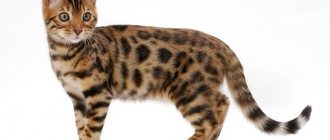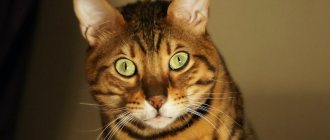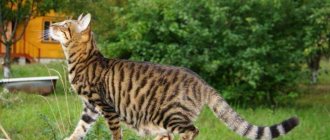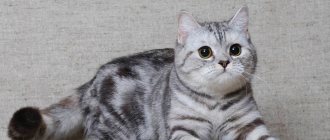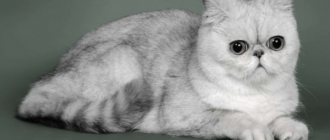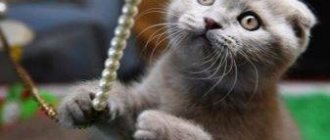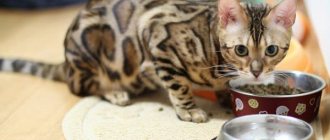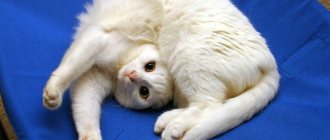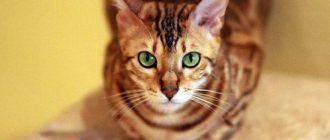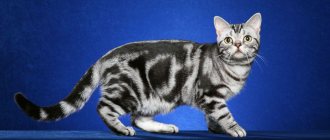History of the origin of the breed
America is considered the birthplace of the Bengal cat, and we are grateful to the American scientist Jane Mill for its appearance. The biologist crossed an American domestic cat and an Asian leopard cat, which she brought back from a business trip to Bangkok. The first attempts to create the breed were in the 1960s. However, they were not successful due to the difficulty of crossing domestic cats with wild animals. It was only in 1983 that the Bengal cat breed was officially registered with the international association TICA. Russians were able to see the Bengali beauty only in 1997 at an exhibition in Moscow.
Bengal cat breed description
As a result of crossing, we now have the appearance of a wild predator combined with an active and affectionate character. This is confirmed by photos of Bengal cats and rave reviews from their owners.
Bengal breed standard
Breed standards can be called external characteristics that are inherent in these cats, and on which a specialist will give an opinion - this is the “Bengal” breed. These cats are characterized by powerful and developed muscles. The body has strong bones and is slightly elongated. Adults can be quite large. Cats are generally smaller than cats. On a small head there is a wide nose, with fairly convex whisker pads. Large eyes have an oval, almost round, shape. The iris of the eye can have different colors, but it is always bright and rich. All this gives her the appearance of a predator. The characteristic muzzle of Bengals is slightly elongated. The ears are set wide apart, as if “on the sides.” They are small or medium in size and round in shape. The tassels of a lynx are not shown.
Dimensions and weight
At birth, a kitten weighs around 100 grams. Bengal kittens grow rapidly and by 1 month this figure is 500 grams, and by 3 months – 1 kg. Kitties, on average, grow up to 7-9 months, while female seals reach their size by 2 years of life. The average height of the animal at the withers is 25-30 cm, body length is about 90 cm. Due to the fact that cats of the Bengal breed are distinguished by their muscles, their weight is 6-8 kg, while cats weigh up to 5 kg.
For those who want a larger cat, there are specially bred hybrids whose weight will be about 8-14 kg, and the height at the withers will be about 60 cm.
Coat and color
Bengal cats have short and dense hair. The only exception can be made for kittens in adolescence. It feels soft and silky. The advantage of Bengal cats is their color, which comes in two types:
- in the form of spots or rosettes (leopard print)
- in the form of stripes or marble (marble)
The most common is the rosette on gold or silver. You can also find a kitten of charcoal and snow colors. Bengal kittens with a blue color were a discovery.
All color options can be viewed here.
Features of Bengals: glitter and phasing
The concept of “glitter” in the color of the Bengal breed is highly valued, in other words, shine or radiance. These colors are distinguished by incomparable brilliance, especially in daylight. Phasing in Bengals is another ability that our favorite cats inherited from Asian Leopard Cats (ALC). Small cubs needed protection from large predators. So, at the age of about 1 month, they begin to become covered with a whitish-grayish pile, which gradually begins to fade by 3-4 months. The final beautiful and bright coat is formed by 8-9 months of age. Phasing is an integral period in Bengal kittens and is another way to check their authenticity.
For clarity, the first photo shows a 3-month-old kitten. In the second photo he is the same, only at 6 months.
The next photo shows a kitten at the age of 1.5 months and then at 9 months.
Hypoallergenic or not
Many people mistakenly believe that the amount and density of a pet’s fur influences the manifestation of allergies. In fact, allergies are caused by complex compounds that are proteins. They are produced by the animal's sebaceous glands and spread through fur, saliva and urine. Therefore, whether an allergy to a Bengal cat manifests itself is a purely individual matter, as is the amount of protein produced in a particular individual. One thing is for sure: in cats and animals with light fur, protein is synthesized in smaller quantities.
Sample menu by age
The veterinarian or breeder from whom you are purchasing a Bengal kitten will help you create an approximate menu by age. When compiling a diet, take into account age, physical parameters, health status, and living conditions.
Up to a month
For the first four to six weeks of their lives, kittens' main diet is colostrum, the milk of their mother cat. With it, babies receive protective antibodies, nutrients for growth and development.
If a cat refuses to feed her cubs or for some reason the kittens are orphaned, try to find another nursing cat for them as quickly as possible. If this option is not possible, purchase special cat milk substitutes and all the necessary equipment for artificial feeding of kittens from a veterinary pharmacy.
Advice! Whole milk is not suitable for feeding Bengal kittens up to a month old. It is given only in extreme cases. Dilute with water, add one chicken yolk, glucose or sugar. It is best to use goat's milk.
Artificial kittens can also be fed infant formula without sugar or third-party additives. Dilute them with water several times more than indicated in the instructions. At a time, the kitten should eat about 3-5 ml of milk or formula. Feed your pets every two hours around the clock.
1 month
At 1 month, kittens are still fed with mother's milk or, when artificially fed, receive cat's milk substitutes, infant formula purchased in stores or prepared according to special recipes (Tailing's Mixture).
At four weeks you can give your pets their first complementary foods. Boiled minced chicken, chicken fillet, and calcined cottage cheese are given in small quantities.
Kittens are fed every two to three hours. The daily norm is 55-80 ml. When starting complementary feeding, monitor the reaction of the kitten’s body.
2 months
At 2 months, in addition to mother's milk, they can receive a new diet. To feed Bengals, special pates, mousses, and mixtures marked “For kittens” (Royal Canin Babycat Instinctive, Pro Plan JUNIOR) are used.
From natural products, cats are given fermented milk products, low-fat raw meat, scalded with boiling water or boiled meat, whole cow's milk, goat's milk, 10% cream.
Two-month-old Bengals are fed 5-6 times a day. The daily dose of food is 65-95 g. The serving size depends on the speed of growth and development of the kitten.
3 months
At 3 months, a Bengal kitten is fed ready-made food, pates, canned food for kittens, or exclusively natural food. Introduce new foods into your pet’s diet gradually.
The kitten can be given quail and chicken boiled eggs (yolk), raw finely chopped meat (veal, poultry), minced meat, fermented milk products cooked in broth, and cereal milk. Enrich your diet with herbs, stewed vegetables, low-fat baked and boiled fish without bones.
Important! Ask the breeders what they used to feed the kittens. For the first week, feed your pet the same foods, gradually adjusting the diet at your discretion.
Reduce the frequency of feeding, gradually increasing the portion size. The daily norm is 180-260 g. Make sure that the pet is full, but not passed on.
Advice! Whole milk can be completely removed from the diet, as it provokes intestinal upset.
4 – 6 months
Until 6–7 months, a Bengal kitten is actively developing, so the diet should be healthy, nutritious, and fortified.
Character
Despite the fact that the Bengal breed has 20% “wild blood”, its character is affectionate and playful, but not aggressive. It is great for cohabitation with other animals and even dogs; it is not uncommon for a Bengal cat and a dog to become best friends. For children, this is generally a godsend: the cat is very patient, flexible and has high intelligence. Thanks to this, she is easy to train and responds well to training. With the right approach, it will not be difficult to accustom your cat to the toilet.
The character of Bengal cats is somewhat similar to dogs, it is not for nothing that they are called “cat-dogs”. They are active and energetic throughout their lives and age is not a hindrance to this. They love to play with all kinds of toys and splash in the water. A distinctive feature is the manner of communication with a person, which manifests itself in various intonations and sounds. She seems to be talking to you, and sometimes even responds to your comments about her.
And yet, the habits of a wild leopard make themselves felt: the cat has a persistent temperament and a love of freedom. Don't be surprised if your pet doesn't always want to sit in your arms. It must be remembered that the wild Bengal was socialized. Therefore, she does not tolerate loneliness well and may harbor resentment.
Photo of a Bengal cat
Read here Burmese cat - 140 photos, description, basic information about the content and character of the cat
Help the site, share with friends 
Who is a Bengal cat suitable for?
After reading about the playful nature and looking at charming photos of Bengal cats on the Internet, make sure that this breed is really suitable for you:
- you will be able to devote a lot of time to communication and games
- peace and quiet are not a priority
- you can provide the animal with the necessary space to frolic, and ideally climb
- you can easily put up with minor clutter and theft (erasers, pencils and all sorts of small items)
- ready to raise a cat and its harmful character
- agree to cleaning the litter box several times a day
Appearance
The described animal has a unique appearance. Looking at the photo of a Bengal cat, we will see a cute, cute spotted creature with beautiful fur.
The spots of various shapes and colors contain the uniqueness of the representative of the breed.
Their weight is quite large: adult males gain up to 9 kg, and females - 5.5 kg. Strong paws, flexible body, agility and well-developed coordination.
The standard breed has a wedge-shaped head and medium-sized slanted ears. Large eyes are golden or green, almond-shaped.
The Bengal breed is painted in any color except blue. Leopard spots of brown or black are required.
The most expensive Bengal with marbled, snowy or silver coat. Other factors do not fit the description of a real Bengal cat breed.
You need to add a thin tail, well-developed medium-sized paws and a thick, silky coat that is pleasant to the touch.
Owner reviews
We have a girl who is one year old and almost two months old. She has been with us since March 13 last year: COOL!!! Perhaps we were just lucky, the stars aligned and we found exactly our cat, Snowball with blue eyes. Moderately mischievous, not aggressive at all, sociable. If I understood correctly when I chose this particular breed myself, aggression is a defect of the breed, breeders must strictly monitor this point. We were only in two small nurseries - a child (11 years old) played with cats and kittens of different ages for quite a long time and did not receive a single scratch! And now, if a scratch happens, it’s extremely rare that they play or I forgot to do her manicure on time, mostly the cat just plays with her paws and doesn’t let go of her claws. I haven't had a single scratch the entire time. Dr. Kalinin came to see us in November and noted how patient the cat was and not at all aggressive. And after the operation, the cat became even more affectionate))))) She’s not stupid - she understands everything perfectly, looks you in the eye and also loves to talk, but it’s relevant and not stressful at all) In general, we were looking for a companion cat and we found one!
We have two boys, 2 years old and one year old. The character is different, the eldest is phlegmatic, can sleep all day, loves to watch us from the height of the closet, always meets and sees us off, loves guests (everyone, from the courier to relatives), silent (although recently he has become more talkative), always It helps if someone is doing something, he is everywhere, when my husband is changing pipes or I am ironing (he is not even afraid of a steam generator), he loves fresh air, he may not eat at the dacha if he understands that for this he needs to go into the house. The little one is choleric, demands attention with his voice, very loudly, if you sit next to him, he busily climbs onto your knees and curls up in a ball, purring loudly, does not like guests - he hides, can play for hours, but if he sleeps on the radiator, then little can wake him up , in general, he’s a loud guy, he’s a small mover. I agree about the aggression, there’s no aggression, I cut my nails, give me pills, give subcutaneous injections, clean my ears and what else they do with cats, no swaddling, no one scratches me, they just complain with their voices. Of course, they need company - a cat, a dog, a child, an adult, as long as someone is with them and plays.
I have a Bengal cat. Live carcass - about 7 kg. Character - choleric with an awl, it’s clear where. The voice apparatus is such that the neighbors can hear. Especially if the cat decided that he was underfed. He was born on April 1, which apparently influenced his character. We took it from a nursery, but our breeder has now left Russia. There was a funny big-eared miracle with a black tail. A medium-sized cat with a striped snow leopard color was born. Now I’ve calmed down a little, but until I’m three years old... This is the first cat I have ever climbed up the curtains to the curtain rod. He did this until he was 6 months old, then the cornice collapsed along with the cat. Anything that is poorly nailed down = a toy. All objects are played with and chased - car keys, apartment keys, grapes, teaspoons, daughter's hairpins. Then they find themselves in the most unexpected places. Hunter cat. He tracks prey, thinks over a plan, and then starts the hunt. Once I stole a pancake with jam from my husband, hid it and sat there guarding it half the night. I woke up from a growl - the second cat, a Scottish felt armadillo, came too close to the nesting site. There they discovered that the pancake was missing. He is also very sociable. He always talks, tells, proves something. He carries toys in his teeth and asks to play. And it’s better to play, because otherwise he will play himself with all sorts of destruction. My daughter is 6 years old, we have him with her 3. There has never been any aggression towards the child, only if accidentally hurt in a game. The only thing is that a visit to the veterinary clinic turned into a safari - to clean the cat’s ears, several adults held the cat, and his muzzle was tied up like a dog. It didn’t help much... In general, it’s an excellent breed if you have someone to play with.
Care and maintenance
Bengal cats are easy to care for and are quite clean. It will be enough to comb them once a week. They do not require frequent bathing, although they will happily take a bath with you. In terms of hygiene: clean your ears from dirt in a timely manner. We advise you to immediately purchase a scratching post: despite trimming their claws, they will always want to sharpen them.
Your pet's tray needs special attention; it can be closed or with larger sides - they really love to rummage around in it. The Bengal breed has a sensitive sense of smell, so carefully monitor the contents a couple of times a day, otherwise the cat will simply go nearby. We also recommend not to use detergents with a strong pungent odor; after such cleaning, the pet may not recognize the tray. It is better to choose clumping wood filler.
For full maintenance, we recommend that from the first days you acquire a sufficient number of toys and, ideally, a high-quality play set. This way, you will protect your personal belongings, but you will have to get used to the desire to jump on shelves and closets.
How long Bengal cats live at home is 12-15 years, but a life expectancy of 20 years has been noted.
Signs of approaching labor
When a cat asks for a male cat to mate with, the owner needs to find a suitable pet. After the mating of Bengal cats takes place, conception will occur after 24-50 hours. From this moment the countdown begins. In the first month of pregnancy, the pet’s nipples rise and become rounded, and the belly enlarges. Vivid precursors of labor can be observed both 2-3 hours before birth and a day before. If this is the first birth, then the signs often appear earlier, since the body takes more time to rebuild. To understand that a pregnant Bengal cat is about to give birth, the owner needs to pay attention to the following signs:
- loss of appetite due to increased thirst;
- apathy and weakness;
- abdominal movement;
- the appearance of vaginal discharge;
- removal of the plug;
- swelling of the nipples and filling with colostrum.
During false contractions, the pet may meow loudly.
About 5 hours before the kittens are born, the pet begins to hunch over and scream. This behavior is observed due to the development of false contractions. It is this sign that is considered the most obvious symptom of impending labor. False contractions do not cause the uterus to dilate, but prepare it for timely contraction, which helps prevent bleeding. 60-120 minutes before the onset of real contractions, your Bengal's water breaks.
Diseases and how to avoid them
Despite the fact that the breed was developed by crossing species, it has good health. However, Bengal cats are predisposed to certain diseases:
- "Dry nose syndrome." It appears in kittens up to one year old in the form of a dry crust on the nose. Examine your pet more often and take it to a specialist on time.
- Another early age disease is flat chest syndrome. This is caused by the incompatibility of some genes of different species, as a result of which the organs cannot grow in the required volume and the animal dies. This has been recorded at the age of up to 3 weeks.
- Heart disease, or the scientific term "hypertrophic cardiomyopathy", refers to genetic diseases. Only a specialist can identify it.
- Leukemia, a blood cancer in animals, is also a hereditary disease. You can be careful by checking the documents of parents of several generations.
- Most often, representatives of the breed suffer from indigestion and poisoning. This is caused by a weak stomach and intestines. Therefore, it is very important to choose the right food for your Bengal. If you notice a loss of appetite, a lethargic appearance, an increased body temperature, and pressing on the stomach is painful - these are the first signs of intestinal inflammation. Go to the vet immediately and do not self-medicate.
Puberty
Due to the fact that Bengals' ancestors are wild cats, their instinct to reproduce is stronger than usual. Puberty can begin as early as 6 months of age. And along with this all the ensuing processes and behavior. Therefore, we recommend that you weigh the pros and cons in advance and decide on the future fate of the kitten.
If breeding offspring is not your main goal, then we recommend that you carefully study the issue of castration or sterilization. In this way, you will protect your home, your nerves and keep your pet healthy.
If you decide otherwise, then approach this issue thoroughly. Breeding Bengal cats is a rather complex process that has its own rules. One of the main ones is mating exclusively within the breed and with a healthy partner. Otherwise, you risk the appearance of mixed breeds with hereditary diseases. Some breeders are not eager to share their experience in this matter. Here a specialist felinologist can help you, who will examine your animal and give an appropriate conclusion. The felinologist of the club where you will register your pet can recommend candidates for procreation.
How to breed Bengal cats
Photo: breeding features
An unusual breed is bred for two purposes: to preserve the qualities of the breed and for profit. A kitten is not cheap, up to 50 thousand rubles.
Included in the price:
- export of individual specimens from America;
- maintenance, mating and veterinary care;
- the litter is small: 3-4 kittens, which is why the price is higher.
It is important to know: females mature later than males - this is a feature of the breed. If you take your animal to an exhibition, then the cat can be shown from the age of 2, but the female can be shown a little later.
It is best to purchase a kitten from special nurseries. This guarantees the receipt of a purebred animal. Plus, it will be healthy and raised on quality nutrition.
Mating
When buying a small kitten, owners do not always think that animals have a developed instinct for procreation. And over time, they will face such problems as mating and estrus.
The domestic Bengal cat belongs to late breeds: estrus begins at 8-9 months. At the same time, the cat begins to show interest in the opposite sex. Estrus occurs 4 times a year, sometimes more often.
The estrus period goes through several stages:
- Proestrus. The cat rolls around on the floor, rubs against furniture, and behaves affectionately. She won't let the cat near her yet. This period passes in 2-3 days.
- Estrus. The most suitable period for conception is when the cat allows its “object of adoration” to mate. This period lasts 4-8 days.
- Metestrus. The cat calmed down, and the stage for conception came to an end.
- Anetsrus. The interval between heats.
It is important to know: unlike dogs, cats have virtually no discharge. And if they do, they are not abundant and transparent. If the discharge is bloody, you should see a veterinarian.
Not all purebred Bengals are suitable for breeding. Animals that meet all standards and have a bright and attractive appearance are allowed to procreate.
Therefore, the question here is not even about defects in the exterior or the bad character of the animal. Uncontrolled reproduction spoils and deteriorates the breed.
When you buy a kitten, breeders require sterilization, which is usually carried out at 5-8 months.
Castration helps to avoid many problems:
- marks in different corners,
- specific, unpleasant odor,
- aggressive behavior,
- using any secluded place in the house as a toilet.
It will not be possible to change this behavior, because... it is based on instincts. Elimination of these unpleasant moments is castration.
It is important to know: it is believed that a cat must give birth at least once to be healthy. But this version is unfounded. Just as the fact that a cat becomes inactive after sterilization is unfounded. In fact, his behavior remains the same.
Photo: breeding Bengal cats
The Bengal breed is not that easy to breed. The characteristics of the breed were formed over a long period of time. Choosing the right partner is a very important point; experience and knowledge are needed here.
If you are not a professional in this matter, then experienced owners of this breed will help you. Matings are allowed only within the breed, and the appearance of mixed-breed kittens does not contribute to the preservation of Bengals.
But there are no rules without exceptions: mating of Bengal cats with their wild ancestors is possible. This makes it possible to add fresh genes, consolidate existing qualities and introduce new ones.
But this is an unlikely cross: it is quite difficult to buy a wild animal. This can only be done in specially designated nurseries.
There are other difficulties:
- over the course of three generations there are many males who are unable to produce offspring,
- few offspring, some of which die.
- aggression of parents towards kittens is possible,
- find a worthy partner who would be able to highlight the strengths of the breed.
An important task is choosing the right kitten. The baby must not only be beautiful and healthy, but have all the qualities of the standard of this breed.
If it has defects, then they can become entrenched in subsequent generations. A high-quality cat will cost you 3-5 thousand dollars .
At the time of buying:
- We check the pedigree. Parents must have a title, participate in exhibitions, possibly in breeding work, and have awards.
- Must have a complete package of documents and all vaccinations.
- Tests were performed for feline infections.
Next, the search for a partner begins. The meeting is organized on the cat’s territory, so the animals feel more comfortable.
For repeated mating, the cat is left for several days. The time may vary: sometimes Bengals take a long time to get used to each other, sometimes mating does not take much time.
It is important to know: when a cat changes its behavior, this may be a sign of a successful mating. She becomes calmer, does not scream and stops rubbing herself against the surface.
But the reliability is checked using ultrasound after 2 weeks. The cat may not become pregnant during this cycle, then the mating is carried out next time.
The character of the Bengal cat is described in the article: Bengal cat.
Read about Abyssinian catteries in Moscow here.
Pregnancy and childbirth
After a successful mating, an important stage begins: bearing kittens. The duration of pregnancy is on average 65 days. After three weeks, the kittens are already palpable.
Don't try to knead your cat's belly to count the number of kittens. A veterinarian will do this successfully, especially since his consultation will be necessary.
During this period, the cat should eat well (vitamins should be added to the food) and be calm. The expectant mother may become more lethargic, but she still loves to play and move. Therefore, you need to communicate with her; activity will not hurt.
Appetite during pregnancy is excellent. Usually the animal is not restricted in its diet. A special line of food has been created for pregnant cats, which contains everything necessary for the development of future kittens.
Photo: pregnancy and childbirth of a Bengal cat
The place for childbirth should be prepared in advance. It is important that the cat gets used to it and does not try to find other places to give birth. You can use a cardboard box or basket. Place a diaper and soft cloth on the bottom.
It is important to know: childbirth usually takes place without complications or any special problems. But it’s better if there is an experienced person nearby who has already seen how this is done. Keep your veterinarian's phone number handy.
Childbirth in purebred cats can be somewhat more difficult than in ordinary “yard” cats, so the owners should be nearby at this important moment for the animal, especially if it is important to preserve the offspring.
Within 1-2 days, the mammary glands swell and discharge may begin. Then the water will break and the cat will begin to give birth. On the eve of giving birth, a Bengal cat may be next to you, or it may hide.
Each pet has its own character: some begin to scream a few days before giving birth, others endure everything in silence.
If she doesn’t like the prepared place for childbirth, she can start giving birth next to the owner or hide in the closet. Childbirth usually occurs in the evening or at night.
It is important to know: to receive kittens, you need to take towels (such as kitchen towels) to dry the kittens, disposable diapers, scales, a clip, table napkins, and a pen.
Photo: Bengal kittens
The duration of labor is related to the number of kittens. Usually there are not many of them: 3-4. Then the duration of labor is from 4 to 6 hours.
Kittens are born gradually, one after another. But delay is also possible as a protective mechanism.
The cat may sense danger and delay the birth by choosing the right place and time. All conditions must be created for your pet to feel comfortable.
Kittens can be born head first or feet first. Both positions are normal. But it is better if the kitten moves forward with its legs: this way there is more room for movement.
The main thing is that the afterbirth comes out immediately. Otherwise, it will block the passage, and it will be more difficult for the second kitten to get out into the light. There is no need to pull them out. This is done only if the mother’s labor is weak.
Kittens need to be weighed every day. They are born quite small: 90-120g. Weight and size depend on factors such as the cat's nutrition, the number of kittens in the litter, and the duration of pregnancy.
Weak ones with low weight should try to put them to the mother's breast more often. The heavier ones (by weight) are taken to a warm place where they can sleep.
After giving birth, create a comfortable environment for the kittens. Create a cozy, draft-free space. And watch your pets grow.
How to choose a kitten and where to buy it
The price for Bengal kittens on the Internet varies from 3,000 rubles to 15,000 rubles. However, “beware of fakes,” as they say, because this is where, due to your inexperience, you can be given a mixed-breed Bengal instead of a purebred. Also, as a rule, owners are little concerned about the nuances of breeding the breed, and as a result, heredity and health may suffer.
In nurseries the price already ranges from 20,000 rubles to 90,000 rubles. Here their class difference will help you in choosing a kitten:
- Pet (pet) class or kitten for home. This animal is intended as a pet and is subject to further castration/sterilization. Price ranges from 20,000 rubles to 30,000 rubles. This price includes: food and vitamins that a newborn needs, filler and the first treatment against parasites, because it is recommended to pick up a kitten after 3 months of age.
- Breed and Show classes. Representatives of these classes have excellent external characteristics and a symmetrical “correct” pattern. Purchased for the purpose of participating in exhibitions and breeding work. Their price starts from 30,000 rubles and above.
Among other things, a kitten with a rare color or champion parents will be valued at an even higher amount.
The advantage of buying a kitten in a nursery, rather than from someone else, is the opportunity to see the pedigree of the animal down to the 3rd or 4th generation. This will allow you to verify the authenticity of the breed. If you want your kitten to have one, you will have to fork out about 15,000 rubles - 20,000 rubles.
